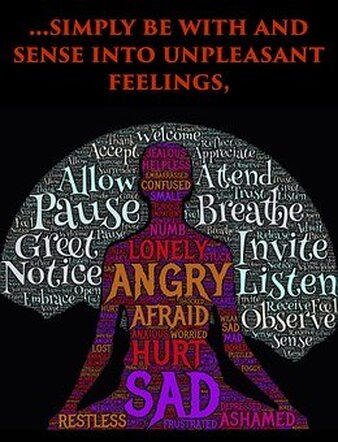ENLIGHTEN UP! a blogSelf-awareness stories: lighting our way to clarity, contentment and resilience in a complicated world.
|
 Photo: Emotions - Credit: John Hain Photo: Emotions - Credit: John Hain These are unsettling times. Our world is dealing with the corona virus pandemic, global warming, terrorism, the refugee crisis, and wars, both military and political. As a result, many of us are experiencing strong emotions. Two of the strongest are anger and fear. Anger can be described as a reaction to situations in which we see red, get seething mad, become fit to be tied, or hot under the collar. Anger can leave us feeling irritated, annoyed, frustrated, hateful or full of rage. In terms of the fight/flight response to stress, anger is the fight response – pushing us to fight our way out of whatever is happening. Fear is an uncomfortable feeling that results from something we recognize, or perceive as an immediate danger or threat. Fear can leave us feeling confused, insecure, anxious, frightened, panicked, or terrified. In terms of the fight/flight response to stress, fear is the flight response – pushing us to get as far away from the situation as possible. Both anger and fear can exist in us at the same time as a result of the same experience. Often it’s anger that masks fear, but sometimes the fear is felt first and masks the anger. These two emotions surface when we find ourselves facing situations that are unpredictable, uncontrollable or due to a long-term, unhelpful core belief. When we understand this, we can unmask the anger and the fear, face the cause and find better responses to whatever set us off in the first place. For example, when my car suddenly broke down on the highway some time ago, my reaction to this situation was clear and direct. First came anger in the form of frustration, irritation and annoyance as in, “Oh, (fill in your favorite swear word). Why now! I don’t need this headache. This (fill in your next favorite one or two swear words) car!” Close on the heels of this reaction, came insecurity, anxiety and fear as in, “No one’s here to help me. I’m alone. How am I going to get out of this? It’s probably going to cost a lot of money (fill in your favorite string of swear words).” Of course, it all worked out. When I calmed myself down, I walked off the next exit, found a gas station, had my car towed and a broken fan belt replaced. This was an unpredictable, uncontrollable event in which I experienced anger first and then the fear that came right along with it. The same reaction can be seen in situations where the emotions arise from a long-term, unhelpful core belief. For example, I’ve inherited a strong belief from the women in my family that independence and personal financial responsibility are important and if you are going to be in relationship with others, adhering to agreed upon commitments, especially around money, is non-negotiable. So, of course, I’ve been tested on that many times and in many ways. One of the most memorable was during my second marriage. We’d agreed on how our finances would be handled but my husband consistently broke the rules. This led to discussions, which led to arguments, which led to a final angry outburst, in which I suddenly connected my anger to a deep-seated fear of financial ruin, that would leave me broke, helpless and dependent. Realistically, there was no way that would happen unless the whole country went into a 1930’s-like depression. After all, I had my own bank account, sound financial investments and a rainy day fund. Once I ‘got’ that it was a perceived fear based on a long-term, unhelpful core belief, I was able to face it, trace it and replace it with clear boundaries and healthier responses when our agreed upon rules were ignored. Maybe it’s age, maybe it’s because I’m now happily single, or maybe it’s my yoga and meditation practice, but these days, my anger/fear stew is slower to reach the boiling point and easier to reduce to a simmer. Emotions are tools of the mind. They are neither positive nor negative. They just are. It’s how we acknowledge, manage and express them that make them helpful or unhelpful. We can unmask and manage our anger/fear stews by understanding the difference between an anger/fear event that can be fixed and forgotten, and a long-term, unhelpful core belief that needs to be faced, traced and replaced. Here’s a witnessing technique for body, breath/energy, and mind that helps unmask anger and fear. Instructions. 1. Physical Body: Bring yourself to a comfortable position seated, standing or lying down. Focus your awareness on your physical body and ask yourself the following questions:
2. Breath/Energy: Next bring your awareness to your breath/energy layer and ask yourself the following questions:
3. Mental-Emotional Layer: Shift your awareness now to your mental-emotional layer and ask yourself the following questions:
4. Finish
“Never let your emotions rule, but always let them testify.” ~Robert Brault
0 Comments
Your comment will be posted after it is approved.
Leave a Reply. |
Archives
July 2024
AuthorBETH GIBBS started her yoga practice in 1968, four months after her son was born and she’s been practicing ever since. She currently teaches all levels therapeutic yoga classes for adults, and specialty classes for seniors in the Hartford, Connecticut area. Beth is a certified yoga therapist through the International Association of Yoga Therapists and is guest faculty at the Kripalu School of Integrative Yoga Therapy. She writes for the blogs, Yoga for Healthy Aging, and Accessible Yoga. Her master’s degree from Lesley University in Cambridge, MA is in Yoga Therapy and Mind/Body Health. Categories |
|
|
Enlighten Up! a Blog
|
Copyright © 2023 Beth Gibbs

 RSS Feed
RSS Feed
